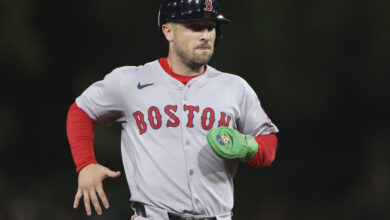
Cubs Should Consider Using Tyler Chatwood as ‘Bulk Starter’ with Help from Opener Next Season
After a dismal first season for the Cubs in 2018, leading the majors with 95 walks, Tyler Chatwood was demoted to the bullpen. He bounced back in 2019 as a swingman and jack of all trades, putting together one of the best seasons of his career. In 2019, Chatwood was 5-3 with a 3.76 ERA (119 ERA+) and 74 strikeouts in 76.2 innings. His 8.69 K/9 was the best of his career, while his 2.0 K/BB ratio was the second-best of his career.
Chatwood remains under contract with the Cubs through the 2020 season and could find himself back in the rotation depending on how things shake out. Cole Hamels says he’d like to return, but he’s a free agent who showed his age down the stretch. The Cubs hold a very reasonable $10.5 million team option on José Quintana, but they could choose not to pick it up or even to trade him afterwards. Yu Darvish can opt out of his six-year deal at the official conclusion of the season, though he has said the Cubs are perfect for him and that he intends to stay.
So the door is open for Chatwood, who has certainly performed well enough for the Cubs to consider returning him to a starting role. If they make that move, however, it may be worthwhile to try using him as the “bulk” or “piggyback” starter behind an opener. This strategy has been employed more frequently in recent years by teams lacking a full five-man rotation or as a means by which to give the starter a softer landing.
A top reliever will pitch the first one or two innings in order to counter the opponent’s most dangerous hitters, followed by a long reliever who’ll work the equivalent of a starter’s workload. The other team doesn’t get a chance to see the opener twice, then the primary pitcher enters to face the bottom of the order.
Chatwood could be more serviceable as a piggyback starter rather than in a more traditional role largely because he’s familiar with entering the game as a reliever. Plus, the change in role from starter to reliever has allowed him to reach back for more velo on his pitches. After maxing out at 97 mph when stretched out, Chatwood’s fastball was up to 99 out of the ‘pen.
Brooks Baseball 2018 Max Release Speeds
Brooks Baseball 2019 Max Release Speeds (as of 9/27/19)
As you would expect, the higher velocity has led to more whiffs. Chatwood’s swinging-strike rate increased to 9.3% in 2019, up significantly from 7.8% the previous seasons. Missing more bats means better strikeout numbers, as seen below.
Overall Numbers, 2018-2019
| Season | ERA | FIP | K9 | K/BB | K% | K-BB% |
| 2018 | 5.30 | 5.60 | 7.38 | 0.89 | 17.5 | -2.1 |
| 2019 | 3.76 | 4.29 | 8.69 | 2.00 | 22.8 | 11.4 |
When looking at Chatwood’s starter/reliever splits, you can see that while 2019 was one of his best years overall, his strikeout numbers are still highest when he pitches in relief.
Role Splits
| Role | ERA | FIP | K9 | K/BB | K% | K-BB% |
| SP | 4.36 | 4.68 | 6.35 | 1.34 | 16.2 | 9.2 |
| RP | 4.53 | 4.67 | 7.59 | 1.75 | 19.3 | 8.3 |
| SP (2019) | 3.97 | 4.50 | 8.34 | 1.75 | 21.4 | 9.2 |
| RP (2019) | 3.67 | 4.20 | 8.83 | 2.12 | 23.5 | 12.4 |
Having a more defined role should be helpful in providing some structure for Chatwood, who was used sporadically under Joe Maddon this past season. He was called upon so infrequently that he said he was “just excited to pitch” after making a spot start in place of an ill Jon Lester on July 24 in San Francisco.
Bullpen management was one of the main criticisms of Maddon’s performance during five years in Chicago, despite his claims that fans know nothing about it, so that will surely be a focal point for the new manager. Giving Chatwood regular innings as a long reliever, a role in which he has done well, could be a boon to both the rotation and the bullpen as the Cubs look to retool this winter.
Efficient use of the roster and putting players in situations in which they perform best will be important if the Cubs want to make a return to playoff contention in 2020.



